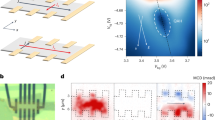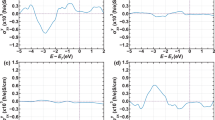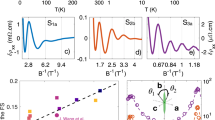Abstract
The generation, manipulation and detection of spin-polarized electrons in low-dimensional semiconductors are at the heart of spintronics. Pure spin currents, that is, fluxes of magnetization without charge current, are quite attractive in this respect. A paradigmatic example is the spin Hall effect, where an electrical current drives a transverse spin current and causes a non-equilibrium spin accumulation observed near the sample boundary1,2. Here we provide evidence for an another effect causing spin currents which is fundamentally different from the spin Hall effect. In contrast to the spin Hall effect, it does not require an electric current to flow: without bias the spin separation is achieved by spin-dependent scattering of electrons in media with suitable symmetry. We show, by free-carrier absorption of terahertz (THz) radiation, that spin currents flow in a wide range of temperatures. Moreover, the experimental results provide evidence that simple electron gas heating by any means is already sufficient to yield spin separation due to spin-dependent energy-relaxation processes.
This is a preview of subscription content, access via your institution
Access options
Subscribe to this journal
Receive 12 print issues and online access
$259.00 per year
only $21.58 per issue
Buy this article
- Purchase on SpringerLink
- Instant access to full article PDF
Prices may be subject to local taxes which are calculated during checkout




Similar content being viewed by others
References
Kato, Y., Myers, R. C., Gossard, A. C. & Awschalom, D. D. Observation of the spin Hall effect in semiconductors. Science 306, 1910–1913 (2004).
Wunderlich, J., Kaestner, B., Sinova, J. & Jungwirth, T. Experimental observation of the spin-Hall effect in a two-dimensional spin-orbit coupled semiconductor system. Phys. Rev. Lett. 94, 047204 (2005).
Tarasenko, S. A. & Ivchenko, E. L. Pure spin photocurrents in low-dimensional structures. Pis’ma Zh. Eksp. Teor. Fiz. 81, 292–296 (2005) ibid. JETP Lett. 81, 231–235 (2005).
Ganichev, S. D. et al. Spin-galvanic effect. Nature 417, 153–156 (2002).
Ganichev, S. D. et al. Conversion of spin into directed electric current in quantum wells. Phys. Rev. Lett. 86, 4358–4362 (2001).
Ganichev, S. D. & Prettl, W. Intense Terahertz Excitation of Semiconductors (Oxford Univ. Press, Oxford, 2006).
Seeger, K. Semiconductor Physics (Springer, Wien, 1997).
Bel’kov, V. V. et al. Magneto-gyrotropic photogalvanic effects in semiconductor quantum wells. J. Phys. Condens. Matter 17, 3405–3428 (2005).
Tarasenko, S. A. Spin orientation of a two-dimensional electron gas by a high-frequency electric field. Phys. Rev. B 73, 115317 (2006).
Ivchenko, E. L. & Pikus, G. E. Optical orientation of free carriers spins and photogalvanic effects in gyrotropic crystals. Izv. Akad. Nauk SSSR 47, 2369–2372 (1983) ibid. Bull. Acad. Sci. USSR 47, 81–84 (1983).
Kelly, M. J. Low-Dimensional Semiconductors (Clarendon, Oxford, 1995).
Acknowledgements
We would like to thank I. Gronwald for help in sample preparation. This work was supported by the DFG through Project GA-501/5, Research Unit FOR370 and Collaborative Research Center SFB689, the RFBR and programs of the RAS. S.G. thanks the HBS and S.A.T. thanks the Foundation ‘Dynasty’–ICFPM and the President Grant for young scientists for support.
Author information
Authors and Affiliations
Contributions
Project planning, model and writing: S.D.G., V.V.B., S.A.T., E.L.I., D.W., W.W., W.P.; experiments and data analysis: S.D.G., V.V.B., S.N.D., S.G., Ch.H.; sample growth and characterization: W.W., Ch.G., D.S., J.S., J.B., G.B.; theory: S.A.T., E.L.I.
Corresponding author
Ethics declarations
Competing interests
The authors declare no competing financial interests.
Rights and permissions
About this article
Cite this article
Ganichev, S., Bel’kov, V., Tarasenko, S. et al. Zero-bias spin separation. Nature Phys 2, 609–613 (2006). https://doi.org/10.1038/nphys390
Received:
Accepted:
Published:
Issue date:
DOI: https://doi.org/10.1038/nphys390
This article is cited by
-
Polarization-controlled tunable directional spin-driven photocurrents in a magnetic metamaterial with threefold rotational symmetry
Nature Communications (2022)
-
Spin photogalvanic effect in two-dimensional collinear antiferromagnets
npj Quantum Materials (2021)
-
Two-dimensional centrosymmetrical antiferromagnets for spin photogalvanic devices
npj Quantum Information (2021)
-
Switchable magnetic bulk photovoltaic effect in the two-dimensional magnet CrI3
Nature Communications (2019)
-
Observation of anomalous linear photogalvanic effect and its dependence on wavelength in undoped InGaAs/AlGaAs multiple quantum well
Nanoscale Research Letters (2014)



